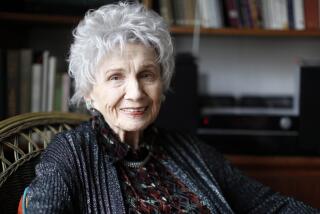Book review: ‘Patricia Highsmith, Selected Novels and Short Stories’
- Share via
The Texas-born, New York-educated, Europe-dwelling Patricia Highsmith (1921-95), whose genre-bending fiction is hard to pigeonhole, excelled at depicting extreme emotional and psychological states — as demonstrated in “Patricia Highsmith: Selected Novels and Short Stories,” which contains her first two novels plus 13 stories, with an introduction by her most recent biographer, Joan Schenkar.
Highsmith’s first book, “Strangers on a Train” (1950), is the disturbing tale of a forced folie à deux between an alcoholic young psychopath and the architect he ensnares in a nightmarish, homicidal scheme. Her second novel, “The Price of Salt” (1952), done under the pseudonym Claire Morgan, is the semi-lyrical chronicle of a love affair between two women. Each a commercial success, these works are quite different in tone and content, but both are done with a skill and an artistry that utterly convince.
“Strangers,” told from alternating points of view, races pell-mell toward a fateful crossroads, fueled by its twin protagonists’ manic compulsions and elective dreads. (Its first sentence: “The train tore along with an angry, irregular rhythm.”) The frightening “partnership” of Guy and Bruno — together they’re Jekyll and Hyde — is a fictional twist on the real-life Leopold and Loeb, a dual-portrait of Nietzsche’s superman in a fun-house mirror, and a definitive case study in the type of story labeled “noir.” With its tug of war between willful delusion and enlightened revelation (“Hatred was the very seed of evil,” Guy thinks), “Strangers on a Train” is a moral-vertigo thriller: “Crime and Punishment” for a post-atomic age.
“The Price of Salt” is a more naturalistic work, but its account of the blossoming relationship between a 19-year-old female set designer in Manhattan and the beautiful married woman she falls in love with was shocking at the time — almost as shocking as Nabokov’s later “Lolita,” which it may have influenced. “Salt’s” most startling aspect perhaps was the ease with which its heroine, Therese, accepted her sexual preference. “Happiness was like a green vine spreading through her,” she feels, entwined with her lover, “… she did not have to ask if this was right, no one had to tell her, because this could not have been more right or perfect.” But peril intrudes (in the form of a husband’s hired detective) and with it come fear and shame.
The best of Highsmith’s short stories are full of strange but credible figures and odd-angle descriptions that still seem fresh. Her shadowy characters move in and out of light and darkness as they seek others with whom to share their solitary lives and alarming visions. Dubbed “the poet of apprehension” by Graham Greene, Patricia Highsmith was a formidable artist — as troubling and all-American as that other terror-struck romantic whose birthday she shared, Edgar Allan Poe.
Tom Nolan is the author of “Three Chords for Beauty’s Sake: The Life of Artie Shaw.”
More to Read
Sign up for our Book Club newsletter
Get the latest news, events and more from the Los Angeles Times Book Club, and help us get L.A. reading and talking.
You may occasionally receive promotional content from the Los Angeles Times.







